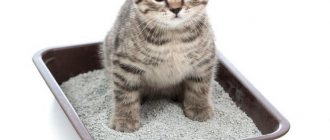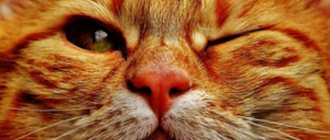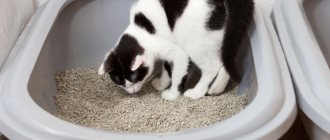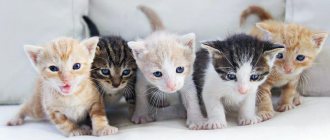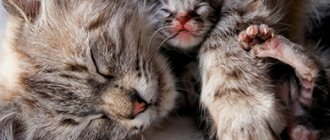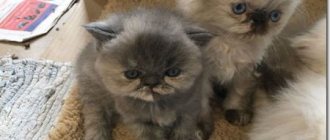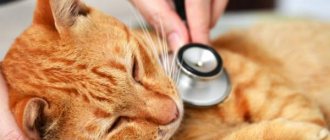Giving birth to a cat is an exciting process for the pet and its owners. The birth of one baby, contrary to the expected brood, raises concerns. Perhaps the cat did not give birth to all the kittens and surgery is necessary to remove the remaining cubs in the womb. But you should not panic if there is only one kitten in the mother's litter. In this case, all that is required from the owners is knowledge of the physiology of the pet and the ability to distinguish normality from pathology in time.
Can a cat not give birth to all kittens at once?
Usually, when a cat gives birth, kittens are born one at a time with an interval of 5-20 minutes.
The birth of kittens from a pet is an exciting and important event.
But due to the physiological characteristics of the animal, all the babies may not appear immediately, but after a certain time interval of several hours. Sometimes the pause lasts a day and a half, then contractions begin again, and one or two more cubs are born.
A break after the birth of a single kitten is a rare occurrence; this is a serious reason to be wary and carefully observe the behavior of the mother in labor.
The animal should be taken to a veterinary hospital if the following signs of complications appear:
- the cat does not show maternal care, is weakened, lies without changing position;
- attempts appear periodically;
- refuses to drink and eat;
- abdominal muscles are toned;
- Blood continues to leak from the vagina.
It happens that the fetuses die in the uterus, then a couple of days after birth the animal’s condition deteriorates sharply. The temperature rises, the animal experiences pain, and foul-smelling brownish-green discharge is observed from the vagina.
There is reason to be wary
Some dream books negatively interpret what lifeless kittens may dream of. It is believed that these crumbs, accidentally strangled by the mother cat, warn the sleeping person about the dangers that threaten him. And if he himself killed a baby cat in a dream, then this is a signal - in real life you need to behave much more carefully and carefully, otherwise one wrong step will cause the collapse of all plans and dreams. Dream books also do not advise taking the initiative once again.
In general, a dead kitten in a dream represents potential troubles, the cause of which can be either sluggishness or excessive haste or fussiness.
And one more thing: take a closer look at the people around you; it is possible that among them there is an ill-wisher who is intentionally limiting your access to important information.
How to understand how many kittens a cat has in the womb
It is impossible to visually determine how many embryos are in a cat’s belly, since the size of the abdomen is not considered an objective indicator. Its volume is affected not only by the number of fetuses, but also by amniotic fluid.
It is impossible to visually determine how many embryos are in a cat’s belly.
If the pet has one kitten in the womb, then the pregnancy may not be noticed at all.
Palpation shows the presence of fetuses in the uterus, but it is also impossible to give a specific number. In this case, intense palpation can harm the embryos and the normal course of pregnancy.
Ultrasound examination is considered a reliable diagnostic method. This is a safe way to determine the exact number of offspring. Carried out by a veterinarian in a veterinary clinic. The procedure is recommended if the cat has already had difficulties during childbirth.
Be sure to read:
After giving birth, the cat has bleeding on the 2-3rd day, is restless, meows and breathes quickly
Features of feline birth
Any cat owner should be aware of the nuances of their pet's reproduction and the stages of pregnancy. It is recommended to perform an ultrasound on the animal in time to ensure normal gestation and determine the number of kittens in the womb. You can find out about an approaching birth by the characteristic behavior of a cat: the expectant mother rushes around the apartment in search of a secluded place, licks her belly, and loses interest in food. Contractions begin after the mucous plug and amniotic fluid have drained. As a rule, kittens are not born immediately, but at intervals of 15-120 minutes. In some cases, the entire labor period lasts up to one and a half days. On average, a litter of a healthy and mature pet contains from 4 to 6 babies.
Yard cats, unlike their purebred counterparts, tend to be more fertile, and their births are easier. In addition, first-born cats are characterized by a small litter: no more than one or two kittens per litter.
It is advisable that a doctor be present at the first lambing of your pet.
It should be understood that during childbirth the animal is especially vulnerable, so it is necessary to notice the signs of an imminent birth in time and be close to the animal at the crucial moment. Usually a woman in labor copes with her task without any problems, but in some cases she cannot do without human help. It is recommended to take the first birth under the supervision of a veterinarian.
If the fetus is in the birth canal, what to do?
Sometimes the fetus gets stuck in the birth canal due to its large size or incorrect position, sometimes difficulties arise due to lack of lubrication or insufficient strength of uterine contractions.
In this case, there is a high risk of death for him and the kittens remaining in the uterus. If a situation arises, you must immediately call a veterinarian or take the cat to a veterinary hospital.
Attention! You should not try to help the cat yourself, especially if you do not have enough experience in obstetric care. It is strictly forbidden to pull the fetus by the limbs: unprofessional actions can lead to rupture of the vagina and kill the kitten.
Noble dream book
If you believe this book, then dead cats that were covered in blood portend misfortune. But they will not affect the dreamer, but his family and friends. It is worth looking after them and taking care of them.
Animals drowned and a person saw them swimming in the water? This means troubles in your personal life. Most likely, something will shake the dreamer’s love relationship. And it’s better to immediately stop the conflict if it arises, otherwise everything can flare up so much that a breakup cannot be avoided.
This is not all that this dream book talks about. Dead cats that went to the next world because of bullying portend disappointment. A person will experience it in relation to those people whom he trusted. And if the animals didn’t have heads, it means a real war is coming at work with colleagues. It is possible that for a high position.
We invite you to read Dream about a white cat
A dead animal, according to this book of interpretations, foreshadows the disappearance of the person who is unpleasant to the dreamer. Was the cat black? You should prepare for the fact that someone wants to cause harm. Perhaps the ill-wisher is in a circle of close people - this is what the dream book assures.
A dead cat in a dream that turns out to be strangled means sad consequences to which the sleeping person’s lifestyle will lead.
If the poor animal died because of the abuse inflicted on it by the dreamer, the person’s conscience is unclean. And soon it will come back to haunt him.
Can a cat have one kitten?
Usually a cat gives birth to 3-6 or more kittens.
Usually a cat gives birth to 3-6 or more kittens, the birth of one kitten is also possible, this happens in the following cases:
- the animal is too young or the cat has reached old age and is finishing its reproductive functions;
- low quality of cat sperm due to illness or old age;
- genetic predisposition;
- death of embryos at an early stage;
- a disease of the reproductive system in a cat, which affects its fertility.
There is a possibility of the birth of an only kitten, but the owner should not leave everything to chance. It is possible that problems arose during childbirth, so it is necessary to carefully monitor the pet.
If you suspect that the cat cannot give birth to the remaining kittens on her own, urgent measures must be taken.
Important! Sometimes the reason for the birth of a small number of offspring should be sought in the use of hormonal drugs that prevent conception. Stress caused by frequent use of hormones negatively affects the reproduction of animals, which affects the number of babies in the litter.
Pet health hazard
If fetal resorption occurs in a cat at an early stage of pregnancy, there is no need to worry about its health. As for spontaneous abortions, which occur in the later stages, they cause serious damage to the reproductive organs of the pet (rupture of the uterus or birth canal). Very often, large quantities of pus accumulate in the uterine cavity. In rare and most advanced cases, the cat develops intoxication of the body, which can lead to its death. That is why timely provision of assistance is very important.
What to do if the cat cannot give birth to the “last baby”?
When a cat has already given birth to several kittens, but there is a suspicion that not all the babies were born, urgent measures must be taken.
Attention! It is not advisable to independently check the presence of an unborn baby in a cat’s belly: it is unlikely that you will be able to feel the fetus with your fingers, but it is easy to harm it and the mother. Therefore, the only correct decision is to contact a specialist for an ultrasound.
In the absence of elevated temperature and spasms in the bronchi and heart rhythm disturbances, Oxytocin may be administered intramuscularly or into the withers to resume labor.
Sometimes the reason for the birth of small offspring should be sought in the use of hormonal drugs that prevent conception
The dosage depends on the weight of the animal, no more than 0.2-0.3 ml. If the medicine does not work, repeat the procedure after 20 minutes. If there is no result, a caesarean section can save the situation.
Important! The drug is not used if the birth canal is blocked by the fetus. The use of stimulants accelerates the separation of the placenta, which can lead to the death of the kitten and causes uterine rupture.
Signs of unfinished labor
Before taking action, you need to check whether the cat can give birth to not all kittens at once. The situation can be found out by observing it. Signs that not all kittens have been born include the following:
- Mom lies on her side without changing position. There is little or no interest in children;
- the cat does not want to eat or drink;
- when observing an animal, you can periodically see how attempts occur;
- if you carefully palpate the tummy, you can feel a strong muscle tone;
- the mother has had a fever for a long time;
- Blood discharge is noticed from the uterus, during which an unpleasant odor can be felt.
Important! If there is an assumption that not all babies were born, it is necessary to call a specialist as soon as possible and send the cat to a veterinary clinic. In such cases, an ultrasound examination is performed to clarify the clinical picture and measures are taken according to the situation.
Bleeding may mean labor is not over
Is there a chance to save a kitten during a caesarean section?
The doctor cannot guarantee that unborn kittens can be saved by caesarean section. Since it is possible that the fetuses died due to hypoxia due to their prolonged stay in the uterus. The operation is more necessary for the cat itself to save its life.
Be sure to read:
A pregnant cat has bleeding: normal or pathological, what to do when you need help
Sometimes surgical intervention cannot be performed urgently due to contraindications. This is due to the fact that the operation requires stable operation of all body systems, but if the animal has a violation of cardiac and respiratory functions, it may not withstand the load and die.
If the kittens suffocated in the womb, and the decomposition process has already begun, performing a cesarean section is pointless, since necrotic changes spread to the uterine cavity.
This requires surgery to remove the organ and ovaries, since there is a high risk of developing septic complications and death.
Intrauterine death of kittens - causes and consequences
Most often, the reasons for the death of kittens before birth lie in intrauterine developmental disorders . Some embryos may die during multiple pregnancies. In this case, we can say that the body gets rid of excess load. In this case, the mother's body absorbs dead embryos. Congenital malformations that are incompatible with life may arise due to genetic defects or poor quality care for the mother in the early stages of pregnancy.
Quite often, intrauterine malformations are associated with chronic diseases of a pregnant cat . Constant stress, cold, physical damage, trauma and other external factors can lead to intrauterine death of kittens. It has been established that a deficiency of taurine in a cat's diet leads to a slowdown in the development of muscles and bones in fetuses. During cat pregnancy, it is not advisable to use any medications (especially toxic ones) without the prescription and supervision of a veterinarian.
Signs of the end of labor
The end of labor in a cat can be understood by the following signs:
- breathing becomes smooth and calm;
- heart rate becomes stable;
- the pet begins to actively lick the kittens, lie on its side so that it is easier for them to reach the nipples, and purrs;
- the animal needs water and food;
- an hour after the birth of the last kitten, muscle tension goes away and the belly becomes soft.
The cat leaves the nest for a short time to eat.
How does the first birth go?
A cat giving birth for the first time will behave restlessly. She does not understand what is happening, she may even be scared of her newborn offspring. Most often, pets give birth early in the morning or during the day. If the owner carefully monitors the animal, he will not miss the time of birth.
In three to four days, colostrum appears, and within a day the genitals will begin to enlarge. Pink or brown discharge may appear. Also, on the eve of birth, the pet’s behavior changes. To help her, you must first prepare the place for birth in advance so that she can get used to the new house. Place a bowl of water and food nearby. It is advisable that the tray also be placed closer (but at a distance from food and water). A week before the expected due date, it is advisable to take the animal to the veterinarian.
There is no need to be near the box all the time. After the birth of her first baby, mom will be busy. But it’s better not to go far, as in the process she may need human help.
It is advisable to have bowls of food and water near the cat.
Veterinarians' Answers to Common Questions
A cat leaves the nest for a short time to eat
For cat owners who have not yet experienced the birth of an animal, the birth of kittens from a pet is a serious cause for concern.
After all, they do not know about the peculiarities of the course of childbirth and preparation for a responsible process. Veterinarians provide advice and answer common questions from new breeders.
How to prepare for the birth of a cat?
In order for your pet to give birth normally, it is important to provide the animal with optimal living conditions and adequate nutrition during pregnancy.
10-14 days before giving birth, you need to prepare a nest for the pet where the animal will give birth. Usually this is a box or a spacious basket, where the cat will feel comfortable and safe. The bottom is lined with several layers of flannel or fleece fabric, which you don’t mind throwing away later. You need to accustom your cat to the place in advance, otherwise she will choose a secluded corner for herself.
When the time comes for the birth of offspring, despite the fact that in 99% of cases everything goes well, it is necessary to prepare for the process a week before the expected due date. This is especially important if the cat gives birth for the first time.
What items are needed:
- clean cotton cloth and napkins;
- syringes and petroleum jelly;
- antiseptic solution (regular iodine will do);
- silk thread;
- tweezers and nail scissors;
- latex gloves;
- bandage or gauze.
Medical supplies will be needed if the cat is unable to chew the umbilical cord on its own or if it needs to be delivered.
Advice! It is recommended to stock up on the phone number of a veterinarian, who is available 24 hours a day, and a notepad to document the time of birth of the babies and the expulsion of the placentas. The data will be important if specialist help is needed.
Features of childbirth in a cat: how kittens are born
The duration of labor and the peculiarities of its course in cats are determined by the following factors:
- age;
- breed;
- state of health and hormonal system;
- conditions of keeping and nutrition of a pregnant animal.
Be sure to read:
Miscarriage in a cat: symptoms, reasons, what to do, why kittens are born dead
You can determine the approach of childbirth by the behavior of your pet: she licks herself more often, hides in dark corners. Sometimes it relentlessly follows the owner, caresses him, demanding attention, or shows displeasure if he wants to pet her. Pinkish discharge is noticeable from the birth canal.
If a cat gives birth for the first time, and instinct does not “tell” her an algorithm of actions, the owner will have to help the kitten himself
Kittens appear after the start of pushing, move forward with their heads, sometimes with their hind legs. The fetus is enveloped by an amniotic sac, and sometimes it ruptures as it passes through the birth canal. The caring female herself frees the cub from the film and bites the umbilical cord.
Important! If a cat gives birth for the first time, and instinct does not “tell” her an algorithm of actions, the owner will have to help the kitten himself. Internet users can watch the process of cutting the umbilical cord on video.
How many times a year does a cat get pregnant?
Due to physiological characteristics, an adult cat is capable of becoming pregnant 3, even 4 times in a year, but this rate depletes the animal’s body and leads to pathological metabolic processes and changes in internal organs.
It takes 8-14 months for an animal to fully recover after childbirth and feed its offspring. Therefore, the optimal number of pregnancies per year is 1, maximum 2 times.
How long does this physiological process last?
The average duration of pregnancy is 57-71 days after mating. Childbirth occurs earlier in short-haired breeds and with multiple offspring.
Interesting! Representatives of the Scottish breed carry fetuses on average for up to 71 days, hairless sphinxes - 63, English cats - 65, large Maine Coons often live up to 68 days.
Until what age can cats give birth?
Cats are capable of giving birth before the end of estrus; for them it lasts up to 18, less often up to 20 years, but stray animals rarely live to this age.
In addition, the duration of the functions of the reproductive system after 10 years does not ensure the appearance of healthy offspring. Therefore, in older animals, the risk of giving birth to weakened kittens and with pathologies of intrauterine development increases.
Features of childbirth
Childbirth in cats is an individual process. Their duration depends on various factors:
- age;
- physiological state;
- number of births;
- animal breeds;
- living conditions and diet during pregnancy;
- hormonal status of the body;
- individual characteristics, etc.
On average, labor in cats lasts 12-36 hours. This time includes the preparatory period with contractions and pushing. It can last several hours or several days. Then labor begins. Kittens appear one by one. As a rule, between thirty minutes and several hours can pass between the birth of two kittens. But there are times when childbirth lasts a day or even several.
A cat needs human support during birth
There are no specific norms for cat labor. You need to proceed from your own experience and conditionally defined time frames. Contractions on average begin 10–12 hours before the onset of labor. The first contractions are the weakest. The break between them can be 30–40 minutes. During this period, the expectant mother can remain active, drink and eat. A characteristic sign that she is going into labor is that she stops sleeping. In the second stage, the body produces stimulating hormones that keep it awake.
The interval between the strongest contractions is 30–40 seconds. This indicates that the first kitten is already at the birth canal, and there is little time left before pushing. The norm is 2-3 attempts, then a kitten appears. After the first, the amniotic sac containing amniotic fluid comes out. They either burst on their own or are opened by a cat. Then one or two more attempts follow, after which the baby appears. Mom licks him, gnaws the umbilical cord and eats the afterbirth.
Normal time between kittens being born
The average time between the first contractions and the appearance of the offspring is approximately 12 hours. If more time has passed and the kittens do not appear, the help of a veterinarian is needed. If labor remains inactive for a long time, hypoxia may develop - oxygen starvation of the fetus. This can adversely affect the health of the offspring or be fatal.
The average duration of all stages is approximately 24 hours. Their duration is influenced by the number of kittens, the general health of the mother, and external factors. When a cat gives birth, the interval between the appearance of kittens is 15-30 minutes, sometimes it can increase to one hour. All this time, contractions will be repeated between attempts. The intervals between kittens during birth are usually the same.
The interval between the appearance of kittens makes it possible to get the babies in order
The cat gives birth too quickly
Childbirth is sometimes rapid: in this case, kittens come out very quickly. This deviation is considered the most dangerous compared to protracted labor. In the case of rapid labor, all offspring are born in just an hour. This can happen due to stress or miscarriage. Sometimes this can be hereditary. In such a situation, the cat experiences very strong pain due to the short intervals between contractions.
In this case, kittens are born almost without interruption; the cat does not have time or cannot properly lick the cubs or gnaw the umbilical cords, but can eat the placenta or even the kittens. This suggests that either the offspring are not viable, or a miscarriage has occurred.
In case of rapid birth, the kittens will have to be looked after by the owner
During rapid labor, human help is needed: to open the blisters as quickly as possible, clear the airways of fluid and mucus, and wipe the babies.
After this, you need to give the mother a little time so that she can calm down and try to attach the kittens to her nipples. Some cats calmly begin to feed. But there is a possibility that the pet will begin to hiss and growl at the kids. In this case, they will have to be fed by the owner, but they have very little chance of surviving on artificial feeding.
The cat is giving birth for too long
An inexperienced owner cannot always determine whether the birth process is normal. Therefore, it is important to know at what interval a cat gives birth to kittens. Labor is considered protracted and the cat needs help if:
- contractions started 12 hours ago, and the first baby has not yet appeared;
- the birth bubble appears, but there is no effort for 10-15 minutes;
- The first kitten was born more than an hour ago, and the next attempts have not begun.
After the babies appear, the cat licks the kittens and eats the afterbirth
If the birth is protracted, the pet has more opportunities to save the life of her offspring. The owner must monitor how long it takes for the cat to give birth to the next kittens. Sometimes labor stops: not all babies have been born yet, but labor has stopped. This condition can persist for 36 hours. The animal’s behavior can be quite normal: eating, sleeping and other usual actions. When the body is ready, the birth process will begin again.
But such situations are rare. Most often this is associated with a loss of strength and indicates a forced cessation of the birth process. As a result, the fetus remaining inside dies, and toxins begin to enter the body. The same can happen if there are afterbirths inside.
How to determine the number of kittens in a pregnant cat
If you want to find out how many kittens a cat will give birth to, there are several proven methods:
- Based on genetic data. How many babies did your pet's mother have in her litter on average? Most likely, this factor was inherited from her. If the cat's grandmother had an average of 6 goals at a time, then your pet will have the same number. She is unlikely to give birth to more than her ancestors gave birth to.
- Folk way. Count how many mammary glands the cat has swollen during pregnancy? Then subtract two from their number. Of course, no one can guarantee the effectiveness of such a result, but it is used quite often.
- Scientific method. One of the simplest and most common ways to find out how many kittens a cat will give birth to today is ultrasound. It is done 10-14 days before birth, this will allow you to determine the exact number of fetuses.
Under no circumstances should you try to count the number of fetuses in a pregnant cat by palpating her. This can affect the health of future babies and cause stress for the mother herself. The maximum that can be done is to gently stroke the tummy if the cat exposes it herself.
Keep a close eye on your pet. If she had more than one partner at the beginning of her pregnancy, then she is likely to give birth to both fathers, which means that the number of cubs will be greater than usual.
How many kittens can a cat give birth to?
If we consider averages, then an ordinary cat can give birth to 6-8 babies at a time. However, the number of cubs is not just the will of fate, but a confluence of many factors. There is a case in history when a representative of the Persian breed gave birth to 15 kittens at once. It is also not uncommon for 1-2 babies to be born. So, what will determine the number of future babies?
Features of the female body
How many kittens a cat gives birth to depends, first of all, on the characteristics of her body. The first birth is usually a surprise, and then the owners know roughly what to expect from their pet. What will affect the female's fertility:
- Age
: Primiparas and late-parous women are unlikely to have many babies. Most likely there will be about 1-2 cubs.
- Genetics
: if the cat’s mother was fertile, then the daughter will most likely inherit this quality.
- Size
: a miniature cat, even in its prime, will not bring too many kittens, but a large and well-fed female is capable of regularly giving birth to a large number of babies.
- Health
: if the cat has any problems, then she will bring significantly fewer kittens.
If you know the cat’s mother and this is not the first time you have observed childbirth, then it will not be difficult to determine the approximate number of fetuses even without an ultrasound.
Male fertility
The number of offspring is influenced by the characteristics of your cat's partner. For example, his age: if the cat has not reached 1.5-2 years of age or, conversely, is too old, the quality of his semen will be an order of magnitude lower than that of strong and healthy cats. Pay attention to the frequency of matings of the cat - you should not expect a large litter if he fertilizes more than 4 cats per year.
The father's health is undoubtedly one of the most important factors. Infectious diseases or diseases associated with the reproductive system can affect not only the number and condition of the offspring, but also the health of the mother herself. If you have a purebred cat and are looking for a mating partner, be sure to ask for a health certificate, the necessary documents on purebred, and also ask the owners how many kittens are usually born from a given male.
An amazing feature is characteristic of cats - in one litter there can be fruits from completely different fathers. This is due to the fact that eggs in the body are produced directly during mating. Therefore, outdoor cats produce more kittens than planned breeding pets.
Dependence on breed
Without a doubt, the fertility of a furry mother is also influenced by her breed. Surely you have noticed that ordinary street cats often give birth more than indoor cats? This is due to a simple truth - harsh conditions await children on the street, and the chances of survival are much less than at home. Therefore, to continue the race, a larger number of kittens is needed.
Purebred pets are not so fertile. For example, Scottish women give birth to an average of two or three babies at a time, but British representatives are already capable of bearing 4-5 babies. However, not everyone can master even this breed maximum.
